Growing an affordable garden begins with a seed, a seed packet that is. Learning how to read and understand seed packets and all the information that little jacket holds is key to creating a successful garden.
This post may contain affiliate links at no additional cost to you. By making your purchases through the links on this website, IMSL may make a small percentage at no direct cost to you. IMSL only promotes products we use & truly believe in. Please refer to my Privacy & Disclosures for further information. IMSL thanks you for your support!
Growing a garden from seed is maybe the most affordable way to grow an abundance of fruits, vegetables, herbs, perennials, and flowers. Unless you are sourcing your seed directly from someone who saves their own (maybe yourself?), you will be purchasing seed. Understanding the wealth of knowledge that’s included on every seed packet can be daunting.
Not all seed packets are created equal. Information one company shares on their packets can often vary greatly from another. Some will provide great detail & others are vague at best. Frustrating, I know. But arming yourself with a bit of knowledge prior to ordering or purchasing will save time, aggravation and ultimately, money if the wrong choices are made.
WHERE TO PURCHASE SEED
Sourcing organic, heirloom, and quality seed is now an easy task. First place to look? Keep it local. By purchasing locally grown seed you rest assured that the variety and plant will grow. It’s already acclimated to your area’s growing conditions.
Ask at farmers markets, local seed banks, and even your neighbor where they source their seed. Here at IMSL we source a large portion of our seed from New England based companies for this very reason. Johnny’s Selected Seed and Fedco are two of our favorites. By the way no renumeration is received from promoting either company. We are happy to do so as we believe in their product.
That being said, we do still order from other reputable companies that we love. Be sure to visit these two articles for complete listings of our favorite companies.
- “It’s My Favorite Time Of Year! Buying Heirloom Seeds”
- “When Life Hands You Heirloom Seeds Just Plant ‘Em!”
SEED PACKET TERMS YOU NEED TO KNOW
When we first began growing from seed, standing in front of the massive displays of seed offerings at our local nursery & feed stores, I remember thinking what the heck does this mean? Just as seed packets are not created equal, the seeds within those packets were not created equal either. Familiarizing yourself with a few terms regarding how the seed was grown will help you navigate the sea of growing references you may find.
ORGANIC SEED
Organic seeds are seeds that are harvested from plants grown without the use of chemical fertilizers, fungicides, & pesticides. These seeds cannot harbor any genetically engineered traits and are grown in organic soil under strict regulations.
Certified organic seeds are grown under strict certification guidelines, and are not exposed to chemicals during the growth period in the fields, harvesting or processing. This type of seed is sustainably grown and in turn beneficial to all.
IMSL
HEIRLOOM SEED
Referred commonly as “rare seeds”, these seeds are open pollinated (pollinated naturally by birds, wind, etc.), and may be saved and replanted year-to-year.
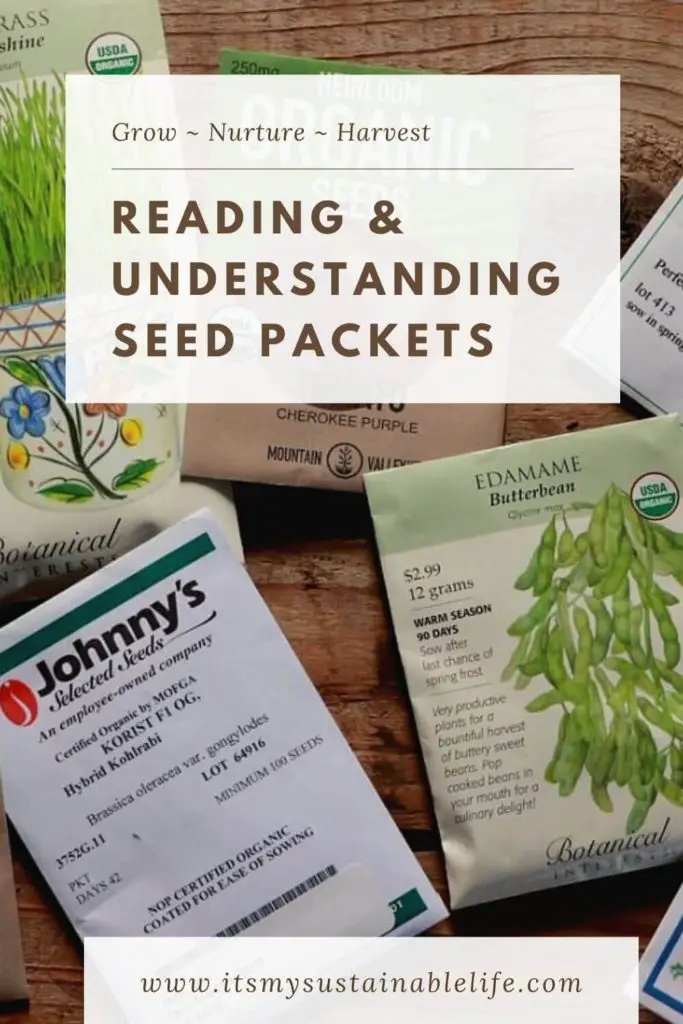
HYBRID SEED
Hybrid seed is seed that has been purposely crossbred to create a new specimen plant. Typically, they are bred with the thought of creating a more dependable plant that’s disease resistant and may create higher yield.
In no way are these seed considered GMO (genetically modified) as many believe. The “hybrid” term is not applied to seed that has naturally crossbred in nature.
GENETICALLY MODIFIED ORGANISM – GMO
Simply put, these seeds are ones that have been created in a lab environment. These seed would never have been created in Nature, and in our humble opinion, should never exist in nature.
These seeds are created in a lab setting using “various genetic engineering techniques” where foreign genetic material is artificially inserted into the DNA.
IMSL
CONVENTIONAL SEED
Conventionally grown seed is seed that has not been altered genetically, but has been grown in the field utilizing the use of pesticides, herbicides, and fungicides, many known to be carcinogenic.
DETERMINATE
Determinate seed create, plants that grow only to a height of roughly 3-4 feet, and are also referred to as “bush” plants, . Requiring little to no staking or support, these plants stop growing once fruit is set on the top bud. The fruit typically will ripen at approximately the same time & are wonderful choices for planting in pots.
INDETERMINATE
Indeterminate seed create plants that can reach a height of 6-12 feet and will continuously grown until killed by frost. Requiring substantial staking for support, these plants will set new fruit that will ripen at the same time throughout the growing season.
Armed with the knowledge of how your seed has been produced and how that plant will eventually grow will set you up for creating the type of garden you desire. Trust me, you don’t want to plan on growing and planting 10 indeterminate tomato plants when you only have one raised bed space to grow them in.
HOW TO READ A SEED PACKET
Exactly what information is included on most seed packets? Let’s take a closer look, both front and back.
FRONT OF SEED PACKET EXAMPLE
Below is an example of the front of a Johnny’s Selected Seed Packet.
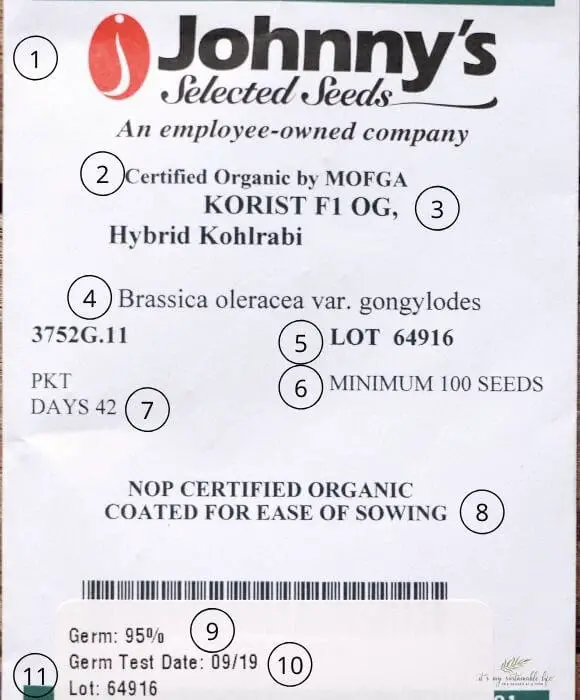
- The company that is providing the seeds. In this case, Johnny’s Selected Seeds. They may also include any company information and contact/website information. Many companies offer growing tips and suggestions on their websites and can be a good resource for gardeners.
- How the seed was produced, in this case they are certified organic by MOFGA (Maine Organic Farmers & Gardeners Association)
- Several bits of information are listed on this line. “Korist” is the cultivar or variety of Kohlrabi. F1 is a reference that this seed is considered a “hybrid”. F1 is an abbreviation Filial 1 which literally translates to “first children”.
- The Latin name of the cultivar/variety.
- The Lot number is listed on all seed packets and may come in handy should there ever be a recall.
- Minimum of number of seeds within the packet.
- An approximate time from sowing to maturity that can be expected.
- Coated or pelleted seed are typically very small seed that have been covered with inert material to create round or evenly shaped seed for ease of planting, especially when using mechanical seeders.
- Germination rate, meaning in this case 95% of seed from this lot germinated successfully. “How To Test Seeds For Viability” discusses how you can test your old seed for viability and why you should.
- The date the germination test was completed.
- Lot number once again.
By comparison, shown below is a typical front view of a seed packet from Fedco Seeds. Pretty much the same information, just in a different format. Fedco seed packets are typically only one sided, and what you see for information is what you get.
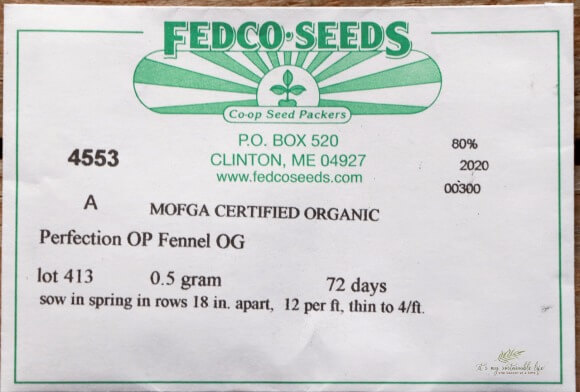
Again, companies information can vary greatly as to what they share on both the front and the back of their packets. Often times further listings of sun requirements and any disease resistant traits may be included.
BACK OF SEED PACKET EXAMPLE
With the example of the back of the seed packet of Botanical Interest, you can see there is a LOT of information included.
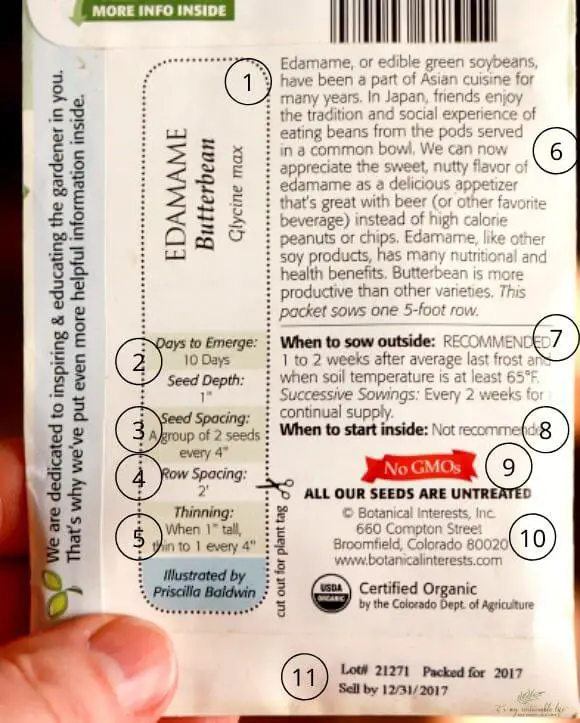
- The type of fruit, vegetable, herb, or flower/perennial name, the cultivar name, and the Latin Name
- The number of days to germination and seed planting information.
- Specific planting instructions for spacing.
- Space needed between rows.
- Thinning information. More on what “thinning” means below.
- Description of the plant itself, what & how it can be used.
- Recommended sowing times.
- Starting recommendations.
- Specific labels that apply to the seed. In this instance, no GMO’s.
- Company contact information.
- Lot number, year packed, and year sold by.
Often you will find instructions on how the seed needs to be treated prior to planting. This may include “pre-soaking” (soaking the seeds for a period of time prior to planting), “scarification” (nicking the seed to penetrate the outer coat of the seed allowing it to become more receptive of water), and “stratification” (exposing the seed to natural conditions, temperature for example, to allow for germination).
DEFINITION OF “THINNING”
Instructions for “thinning” are included on many packets. Many plants such as carrots will call for “thinning”. Thinning is the term used to remove emerging plants that are overcrowded or weak. Often the directions on the packet will state how far apart the remaining plants need to be spaced. For example: “thin to 2 inches” apart.
For more on the thinning process, be sure to look at “Thinning Carrots The No Waste Way”.
For some, this may be a refresher of information they already were aware of. For many, hopefully this can answer a few of the questions that may arise. Hopefully there will be fewer standing in front of the seed display cases with baffled looks on their faces 🙂
What’s on your garden plan this year? Join the conversation below and be sure to follow on all social media to stay up-to-date with what’s “happening on the hill”.
Love, Light, & Laughter


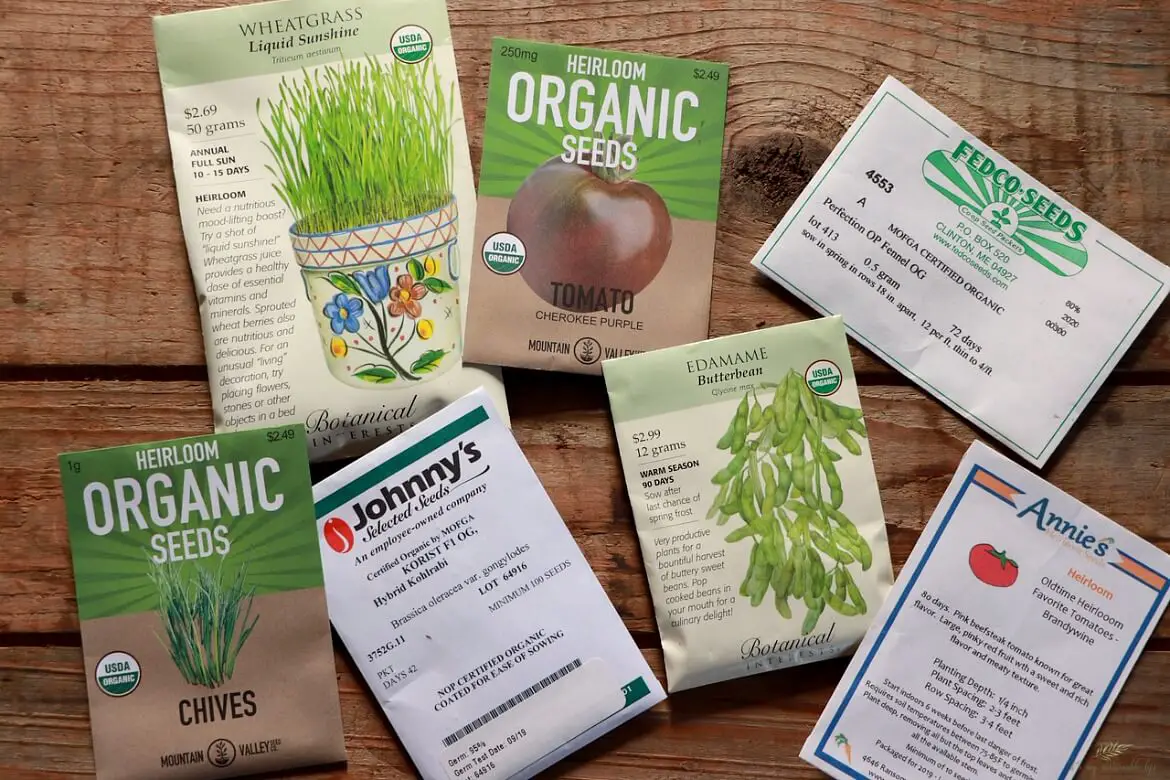
65 comments
Great decoding!
Thank you for sharing at #OverTheMoon. Pinned and shared. Have a lovely week. I hope to see you at next week’s party too! Come party with us at Over The Moon! Catapult your content Over The Moon! @marilyn_lesniak @EclecticRedBarn PLease everyone stay safe and healthy. Hugz.
Oh, wow! Great information! Thank you for sharing this informative post at You’re the Star monthly blog hop! ‘Sharing on Facebook. -Marci @ Stone Cottage Adventures
Thank you Marci for reading & for the share! I appreciate it!!
Wow, I just learned so much. I plan on starting a garden with my kids while we are at home and this has been so helpful. Thank you!
This is so helpful. We’ve been looking into gardening with everything that has been happening.
As are so many others, and with good reason. Don’t hesitate to ask any questions, Lisa. Hopefully a few upcoming posts will be of assistance as well. Thanks for reading!
Ok we garden a lot and I never knew any of this! thanks so much!
I guess I really never realized there could be so much to buying seeds. Thanks for the information.
What a great post. So much wonderful info about seeds that I did not know. Congratulations, you are being featured I hope you stop by.
Hugs,
Bev
Thank you for reading & the feature!
This is really interesting information! I always feel overwhelmed when trying to pick out seeds!
This is great information! There is so much information on the back of seed packets and it can take a bit to deciper! I would love to have a garden. Unfortunately it doesn’t work right now, but hopefully someday!
Thank you for sharing Suzan.. I started planting a few weeks ago. Our seed packets here in our area don’t look quite like that but it’s great to know what all the info means on the back. Appreciate it!
The photo with your dog is just darling…
plus your opening line made me smile.
This is so helpful! I am trying to gather information to start a small container garden. In Arizona, I didn’t think I could grow anything at all. At least this gives me ideas for how to decide what will grow and when to plant based on our dry desert conditions.
I absolutely LOVE buying seed packets every Spring! Thanks for the great info!
This is a very helpful resource for understanding what we are looking at! I always wonder hownmuch past the sell by date you can go.
A lot of great information! Thanks!
I learned SO much from this! I knew the basics, but this has me thinking!!!!
I seriously did not know there were so many variety of how seeds come packaged. I appreciate the breakdown of all the terminology. Totally sharing with all my friends!
My goodness, who knew there was so much to learn about seed packets. I usually buy the plants and not seeds, but I tempted with try seeds. Lots of good information. Thank you.
These are perfect, helpful hints right before I plant my spring flowers, thank you!
Your information is so helpful to those of us who are new to gardening. You really know how to break it down which makes me want to plant something.
A lot of really great and helpful information here. Thank you for helping clarify some of these terms for me.
One of my favorite times of the year–Seed Ordering season! haha. Great info here. Thanks. 🙂
Awesome post! I am a lover of growing my own plants/ flowers.
Wow there is so much more info than I ever thought! Thanks for sharing 🙂
That’s was great information! My mom was always the one with the green thumb in the house. She passed this past fall and I am determined to start a garden but without her I am kind of lost.
My sympathies for your loss. What a wonderful tribute to you Mom, growing something in her honor. You may like to take a peek at https://www.itsmysustainablelife.com/vegetable-gardening-styles-methods/ which gives a good bit of information for beginners as well as https://www.itsmysustainablelife.com/seed-starting-101/ if you haven’t already checked them out. Good luck, and you can always email me with any questions 🙂
This is SUPER HELPFUL! Thank you so much! I’m bookmarking this page so I can refer back again and again. I’ve definitely NOT been paying enough attention (which explains my haphazard luck with plants). I definitely didn’t thin my carrots correctly, so I’m off to read that post. Thank you, again, for a wonderful post and helpful site. Looking forward to reading more!
Hi Kaecey~
I’m so glad you found this post of use. I would recommend going through my Grow It Eat It section on gardening. Maybe there is something there that would be of help as well. Thanks so much for reading & taking the time to join the conversation!
Thank you for this great information! I have been interested in learning to garden for a while now and this will surely help in determining what seeds to look for! You are so knowledgeable and I love the way you explained everything so deeply! And your website is so beautiful!
Thank you, Monica! I’m happy you’re enjoying it!
Thank you! I am always confused while standing in front of the seed display. Last year I gave up and bought seedlings, now I know how to select seeds for my small garden and get the plants the I need/want. Great information!
Oh gosh I love this. My boyfriend and I had a garden we just randomly picked and threw together last year but want to be much more intentional this year. I will definitely be using some of this knowledge!
OMG, I totally needed this to be explained in plain English! Thank you so much!
Thanks for all of these tips!
I’m always amazed at what a wealth of knowledge you are!
Well, I appreciate the vote of confidence & that I can share from all my mistakes 🙂
I’ve learned so much!! I had no idea how much info can be found on the package.
This is such good information for me to have. I have no green thumb and would love to try.
Hoping to garden small this year – boys are going to build me some garden containers and once we take down the swing set a larger garden will go in its place!
How exciting!
With all of our travel cancelled, time to plant seeds. Thanks for sharing all the great info.
This is great info! I had no idea there was so much to know about such a little packet!
Great tips on seeds and thinning and seed terminology. I agree with you on GMO!
Gardening is not my thing but those seed packets do contain a lot of info about zones that I never figure out.
I never realized there was so much to seeds. We love planting veggies each spring.
Such great information! I really am a newbie!
Thank you for clearing up “hybrid”!!
Growing up we always had a garden in the backyard and my dad would try to grow random things each year like pumpkins, potatoes, and tomatoes. We always went to our neighborhood nursery to get seeds and I think he just grabbed whatever looked interesting and would grow that time of year. Maybe he should read this to make more educated purchases! Haha
It does help with the success rate of the garden!
So much information! I feel liked I’m armed and ready for Spring!
Thank you for all of the knowledge and information for us new folks.
thanks for sharing all these awesome tips!
This is very timely! As my daughter and I go into social distancing from school, one of our projects will be planting some seeds. I usually do tomatoes from plants, and that’s about it. Well, except flowers. This year we’re looking to start four veggies from seeds. I’ll need all the help I can get!
Wow, I didn’t know there was so much to understand on growing seeds. I always bought whatever I thought I would like to grow and planted and if it grew it did and if it didn’t it didn’t. Now I also wonder if I read if that will make a difference in the taste. Sometimes my vegetables taste so bitter and other times so wonderful!
An interesting post about reading seed packets
Great guide to understanding seed packets. Sometimes the language can be incomplete or misleading. Thank you!
Great tips and advice, sometimes those. Packets can be so confusing especially for people that might not have gardened or use starter plants!
This information is so interesting to me and helpful. Passing it on to my daughter who is starting her garden from seed.
I often wondered how to read seed packets. Since I have never gardened before, this is very helpful!
Good to know for those who are newbie gardeners! Thanks so much for linking up with me at my #UnlimitedMonthlyLinkParty 10, open March 1 to 26. All entries shared on social media if share buttons installed.
What an amazing explanation for us beginners who are considering trying our hand at seeding! This is so clearly written and well organized, you make it a lot less intimidating.